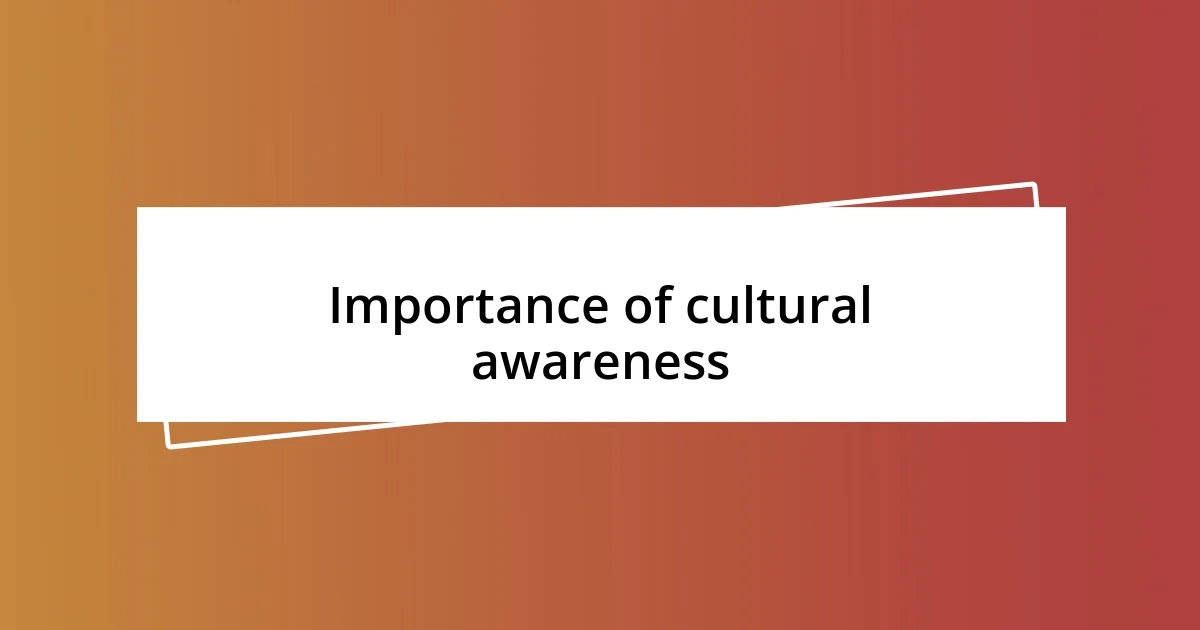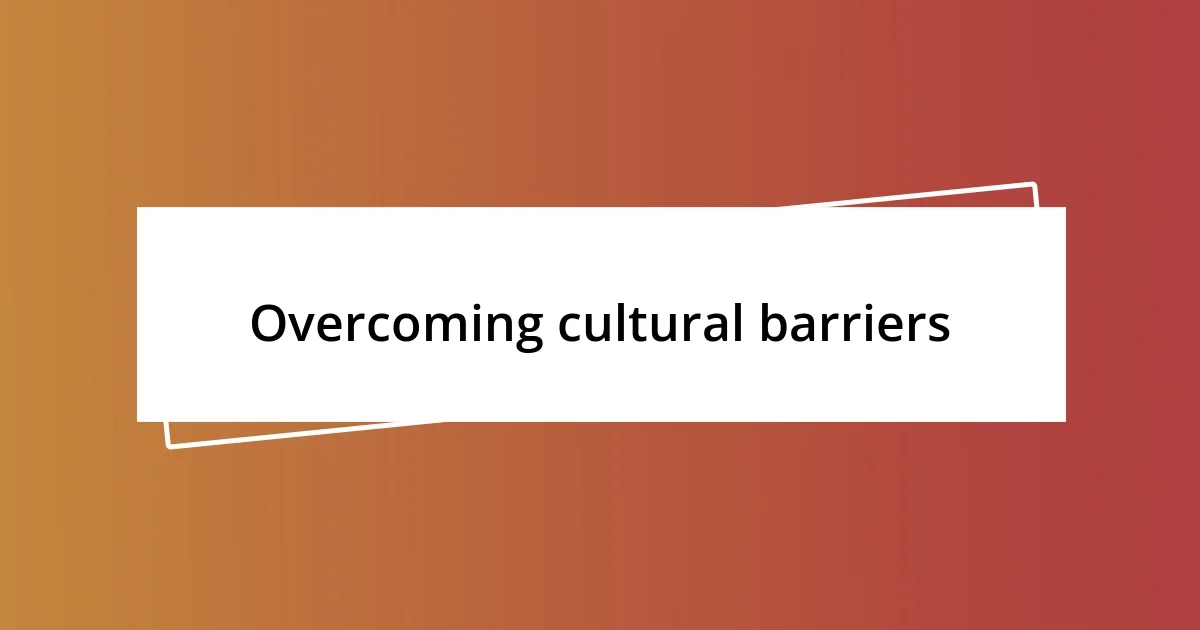Key takeaways:
- Cultural understanding fosters genuine connections and mutual respect through active engagement and curiosity about different customs and traditions.
- Participating in local events and sharing personal stories helps break down cultural barriers, enhancing empathy and communication across diverse backgrounds.
- Reflecting on cultural experiences reveals the significance of shared human experiences, deepening appreciation for culture and its impact on relationships.

What is cultural understanding
Cultural understanding, at its core, is about recognizing and appreciating the diverse ways people live, think, and express themselves. I remember my first visit to a traditional celebration in a different country; the laughter, music, and rituals were foreign yet mesmerizing. How often do we pause to consider the stories and values behind these vibrant customs?
It’s not just about observing cultural differences; it’s about immersing ourselves in them. I once tried to learn a few phrases in a local language before visiting a new city, and that effort brought smiles and open arms from the locals. This experience made me realize that cultural understanding fosters genuine connections and mutual respect.
To really grasp the essence of a culture, one must listen actively and approach with curiosity. Have you ever found yourself in a conversation where you felt a cultural barrier? In those moments, I found that asking questions with genuine interest can unveil rich layers of meaning and shared humanity. It’s these moments of connection that illuminate the beauty of our diverse world.

Importance of cultural awareness
Cultural awareness is vital in our increasingly globalized world. It allows us to look beyond stereotypes and embrace the rich tapestry of human experiences. I recall a dinner I had with a family from another culture; their hospitality and unique culinary traditions opened my eyes to their values and norms, reinforcing how much we can learn from each other.
Moreover, having cultural awareness enhances our empathy and communication skills. During my travels, I often noticed that understanding cultural nuances changed my interactions profoundly. For instance, a simple gesture, like bowing in certain cultures, carries immense significance and can foster respect. It reminded me that acknowledging these small details can bridge gaps and cultivate deeper relationships.
Finally, cultural awareness can lead to personal growth and adaptability. I remember feeling nervous before participating in a local festival; stepping outside my comfort zone allowed me to experience joy and excitement in a new way. Such experiences taught me that embracing cultural differences not only enriches our lives but also helps us see the world through a wider lens.
| Cultural Awareness | Impact |
|---|---|
| Strengthens relationships | Builds trust and openness |
| Enhances empathy | Improves communication effectiveness |
| Fosters personal growth | Encourages adaptability |

Strategies for engaging with cultures
Engaging with different cultures is a hands-on journey that requires genuine interest and an open heart. I vividly recall my experience volunteering at a local community center in a neighborhood vastly different from my own. The sharing of stories and laughter with locals not only deepened my understanding of their culture but also sparked lasting friendships that transcended our differences. By actively participating in traditions and local events, I found that connection blossomed in unexpected ways.
Here are some strategies to enhance your cultural engagement:
- Participate in Local Events: Attend festivals, markets, and gatherings to soak in the culture firsthand.
- Learn Basic Phrases: A simple greeting in the local language can break the ice and show respect.
- Share Your Culture: When appropriate, open up about your background; this reciprocal sharing fosters deeper conversations.
- Use Social Media Thoughtfully: Follow local influencers or communities to gain insights into daily life and local perspectives.
- Be Open to Feedback: Embrace constructive criticism when navigating cultural interactions; it’s a learning opportunity that can strengthen your approach.

Learning through cultural immersion
Learning through cultural immersion is one of the most enriching experiences I’ve encountered. When I visited a rural village, I lived with a host family who welcomed me into their daily life. From cooking traditional meals together to celebrating local holidays, I found that every moment was a lesson in not just the culture, but in the values and traditions that define their existence.
One memorable evening, while helping my host mother with dinner, I learned about the significance of each ingredient and its place in their culinary history. I felt the warmth of her pride as she shared stories of her ancestors and their culinary techniques. It struck me how food is more than sustenance; it’s a bridge to understanding someone’s heritage. Has there ever been a moment for you where sharing a meal opened a door to deeper understanding?
Participating in local customs often leads to unanticipated insights. During a community dance event, I clumsily stepped on toes and shared a hearty laugh with the locals. Their joyous acceptance made me realize that mistakes can be a source of connection rather than embarrassment. In those moments, I felt like part of the family rather than an outsider. It taught me that cultural immersion is as much about vulnerability as it is about celebration; diving in fully allows genuine connections to flourish.

Building relationships across cultures
Building relationships across cultures often begins with a willingness to embrace vulnerability. I remember a time when I attended a potluck dinner in a multicultural community. Everyone brought dishes from their homelands, and as I tasted a spicy curry from a newcomer’s country, I felt the delightful tension of sharing something so personal. How often do we consider food as a thread that ties us together across miles and backgrounds? That night, exchanging recipes and stories established not just connections, but friendships anchored by the warmth of shared experiences.
In my experience, listening plays a critical role in building these cross-cultural relationships. Once, while volunteering at a youth program, I had a heartfelt conversation with a teenager from a vastly different background. When I truly paused to listen to his dreams and struggles, I found common ground that transcended our differences. This connection reinforced my belief that genuine curiosity about others is truly transformative—how can we know each other if we don’t take the time to listen?
Engaging with humor can also be a delightful icebreaker. I recall a funny mishap during a traditional dance class where I tripped and caused a ripple of laughter among participants. Instead of feeling embarrassed, I embraced the moment, and the shared laughter became a shared story that we still recount together. This experience taught me that humor, when shared across cultures, can dissolve barriers and invite a sense of belonging. After all, isn’t laughter one of the most universal languages?

Overcoming cultural barriers
Overcoming cultural barriers requires open-mindedness and a willingness to challenge preconceived notions. I vividly remember attending a community festival where the vibrant displays of different cultures overwhelmed me at first. As I hesitated to engage, I noticed a small group of children playing a traditional game. Their carefree laughter was an invitation I couldn’t resist. Stepping into that joyful chaos, I found myself learning not just the game, but also the importance of play in fostering connections. What would have happened if I had shied away instead of joining in?
Sometimes, it takes a simple gesture to bridge seemingly vast divides. At a multicultural gala, I was unsure how to approach someone who spoke little English. Instead of letting the language barrier intimidate me, I smiled and offered a handshake. This small act transformed the atmosphere. Within moments, laughter erupted as we navigated communication through gestures and animated expressions. It was a reminder that intentions often speak louder than words—how often do we let fear of misunderstanding hold us back?
Sharing personal stories can be a powerful way to dismantle cultural barriers. One rainy evening, I found myself in a group discussion about family traditions. As I shared stories about my own upbringing, I watched as eyes widened in recognition. Suddenly, we were all connected through the universal themes of love, loss, and joy. I realized that these shared narratives invite empathy and understanding—hasn’t everyone experienced moments of longing or celebration? In those exchanges, I found that our differences fade in the warmth of shared humanity.

Reflecting on cultural experiences
Reflecting on cultural experiences often leads me to moments that reveal unexpected lessons. I remember attending a family dinner in a home filled with laughter and traditional music. As I observed the way different generations interacted, I felt the deep respect for heritage that flowed between them. Isn’t it fascinating how culture can shape family dynamics and bind us over shared traditions? This experience encouraged me to reflect on my own cultural narratives and how they influence my relationships.
One poignant memory stands out when I think about moments that shape my understanding of other cultures. While visiting a local market, I encountered an elderly artisan weaving baskets. Watching her hands skillfully create something beautiful made me realize how artistry is a form of storytelling. Have you ever considered how every crafted item holds the essence of its creator’s culture? This insight has made me appreciate the small details in everyday life and how they reflect broader cultural experiences.
There are days when I find myself sitting quietly in diverse settings, taking in the cacophony of languages and laughter around me. It’s during these times that I ponder the bridges we build with mere presence. I once sat on a park bench next to a family enjoying a picnic, their laughter blending with the sounds of children playing. In that moment, I felt a profound connection—not through words, but simply by being part of their shared joy. Isn’t it remarkable how the act of witnessing others’ happiness can deepen our understanding of cultural richness? These reflections emphasize that sometimes, understanding new cultures begins with simply embracing the moment and sharing in the experiences of others.














